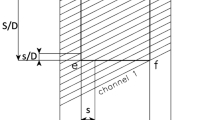Abstract
We present the improved solar radio spectrograph of the University of Athens operating at the Thermopylae Satellite Telecommunication Station. Observations now cover the frequency range from 20 to 650 MHz. The spectrograph has a 7-meter moving parabola fed by a log-periodic antenna for 100–650 MHz and a stationary inverted V fat dipole antenna for the 20–100 MHz range. Two receivers are operating in parallel, one swept frequency for the whole range (10 spectrums/sec, 630 channels/spectrum) and one acousto-optical receiver for the range 270 to 450 MHz (100 spectrums/sec, 128 channels/spectrum). The data acquisition system consists of two PCs (equipped with 12 bit, 225 ksamples/sec ADC, one for each receiver). Sensitivity is about 3 SFU and 30 SFU in the 20–100 MHz and 100–650 MHz range respectively. The daily operation is fully automated: receiving universal time from a GPS, pointing the antenna to the sun, system calibration, starting and stopping the observations at preset times, data acquisition, and archiving on DVD. We can also control the whole system through modem or Internet. The instrument can be used either by itself or in conjunction with other instruments to study the onset and evolution of solar radio bursts and associated interplanetary phenomena.
Similar content being viewed by others
References
Berg, N., Pellegrino, J.: Acousto-Optic Signal Processing. Marcel Dekker Inc., New York, pp. 101 (1996)
Cane, H.: Spectra of the non-thermal radio radiation from the galactic polar regions. MNRAS 189, 465 (1979)
Caroubalos, C., Hillaris, A., Bouratzis, C., Alissandrakis, C.E., Preka-Papadema, P., Polygiannakis, J., Tsitsipis, P., Kontogeorgos, A., Moussas, X., Bougeret, J.-L., Doumas, G., Perche, C.: Solar type II and type IV radio bursts observed during 1998–2000 with the ARTEMIS IV radiospectrograph. Astron. Astrophys. 4131125–1133 (2004)
Caroubalos, C., Maroulis, D., Patavalis, N., Bougeret, J.-L., Doumas, G., Perche, C., Alissandrakis, C., Hillaris, A., Moussas, X., Preka-Papadema, P., Kontogeorgos, A., Tsitsipis, P., Kanelakis, G.: The new multichannel radiospectrograph ARTEMIS-IV/HECATE of the University of Athens. Exp. Astron. 1123–32 (2001)
Erickson, W.: Professor at Utas University of Australia, private communication (2004)
Kivelson, M.G., Rusell, C.T (eds): Introduction to Space Physics. Cambridge University Press (1995)
Keithley KPCL 3100 ADC manual (2002)
Kraus, J.: Antennas. McGraw-Hill, pp. 47 and 778 (1988)
Maroulis, D., Doumas, G., Caroubalos, C., Bougeret, J.-L., Moussas, X., Alissandrakis, C., Patavalis, N.: ARTEMIS MARK IV, the new Greek-French digital radio spectrograph at thermopyles, Greece. Solar Phys. 172353–360 (1997)
McLean, D., Labrum, N.: Solar RadiophysicsCambridge University Press, pp. 126 and 127 (1985a)
McLean, D., Labrum, N.: Solar RadiophysicsCambridge University Press, pp. 39 and 40 (1985b)
Motorola: RF Device Data, Vol. II, pp. 5-40, 7–198-7-207 ( 1991)
Rohlfs, K., Wilson, T.: Tools of Radio AstronomySpringer, pp. 105 (1996)
Tsitsipis, P., Kontogeorgos, A., Caroubalos, C., Moussas, X., Alissandrakis, C., Hillaris, A., Preka-Papadema, P., Polygiannakis, J., Bougeret, J.-L., Doumas, G., Perche, C.: ARTEMIS IV radio observations of the 14 July 2000 Large Solar Event. Solar Phys. 204165–179 (2001)
Tsitsipis, P., Kontogeorgos, A., Hillaris, A., Moussas, X., Caroubalos, C., Preka-Papadema, P.: Fast estimation of slopes of linear and quasi-linear structures in noisy background using Fourier methods. In press Pattern Recognition 2006 (DOI: 10.1016/j.patcog.2006.04.014)
Author information
Authors and Affiliations
Corresponding author
Rights and permissions
About this article
Cite this article
Kontogeorgos, A., Tsitsipis, P., Caroubalos, C. et al. The improved ARTEMIS IV multichannel solar radio spectrograph of the University of Athens. Exp Astron 21, 41–55 (2006). https://doi.org/10.1007/s10686-006-9066-x
Received:
Accepted:
Published:
Issue Date:
DOI: https://doi.org/10.1007/s10686-006-9066-x




